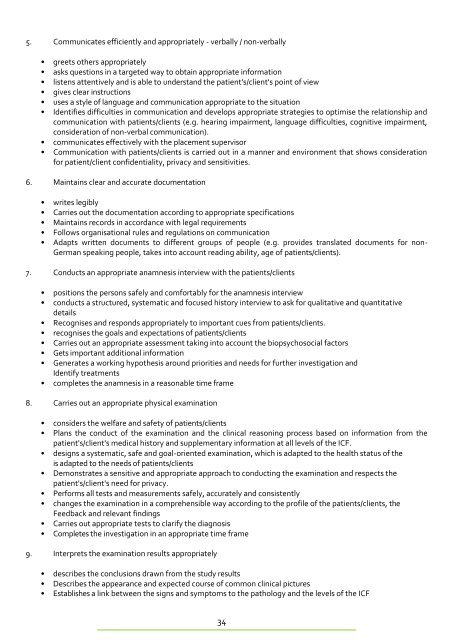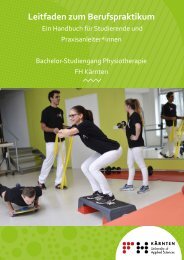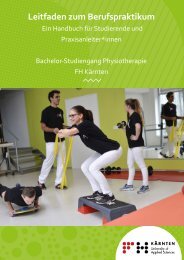Internship/work placement guide
Physiotherapy
Physiotherapy
Create successful ePaper yourself
Turn your PDF publications into a flip-book with our unique Google optimized e-Paper software.
5. Communicates efficiently and appropriately - verbally / non-verbally<br />
• greets others appropriately<br />
• asks questions in a targeted way to obtain appropriate information<br />
• listens attentively and is able to understand the patient's/client's point of view<br />
• gives clear instructions<br />
• uses a style of language and communication appropriate to the situation<br />
• Identifies difficulties in communication and develops appropriate strategies to optimise the relationship and<br />
communication with patients/clients (e.g. hearing impairment, language difficulties, cognitive impairment,<br />
consideration of non-verbal communication).<br />
• communicates effectively with the <strong>placement</strong> supervisor<br />
• Communication with patients/clients is carried out in a manner and environment that shows consideration<br />
for patient/client confidentiality, privacy and sensitivities.<br />
6. Maintains clear and accurate documentation<br />
• writes legibly<br />
• Carries out the documentation according to appropriate specifications<br />
• Maintains records in accordance with legal requirements<br />
• Follows organisational rules and regulations on communication<br />
• Adapts written documents to different groups of people (e.g. provides translated documents for non-<br />
German speaking people, takes into account reading ability, age of patients/clients).<br />
7. Conducts an appropriate anamnesis interview with the patients/clients<br />
• positions the persons safely and comfortably for the anamnesis interview<br />
• conducts a structured, systematic and focused history interview to ask for qualitative and quantitative<br />
details<br />
• Recognises and responds appropriately to important cues from patients/clients.<br />
• recognises the goals and expectations of patients/clients<br />
• Carries out an appropriate assessment taking into account the biopsychosocial factors<br />
• Gets important additional information<br />
• Generates a <strong>work</strong>ing hypothesis around priorities and needs for further investigation and<br />
Identify treatments<br />
• completes the anamnesis in a reasonable time frame<br />
8. Carries out an appropriate physical examination<br />
• considers the welfare and safety of patients/clients<br />
• Plans the conduct of the examination and the clinical reasoning process based on information from the<br />
patient's/client's medical history and supplementary information at all levels of the ICF.<br />
• designs a systematic, safe and goal-oriented examination, which is adapted to the health status of the<br />
is adapted to the needs of patients/clients<br />
• Demonstrates a sensitive and appropriate approach to conducting the examination and respects the<br />
patient's/client's need for privacy.<br />
• Performs all tests and measurements safely, accurately and consistently<br />
• changes the examination in a comprehensible way according to the profile of the patients/clients, the<br />
Feedback and relevant findings<br />
• Carries out appropriate tests to clarify the diagnosis<br />
• Completes the investigation in an appropriate time frame<br />
9. Interprets the examination results appropriately<br />
• describes the conclusions drawn from the study results<br />
• Describes the appearance and expected course of common clinical pictures<br />
• Establishes a link between the signs and symptoms to the pathology and the levels of the ICF<br />
34<br />
34
















